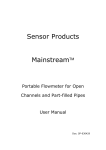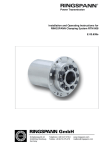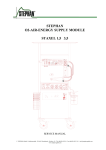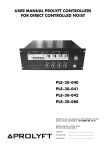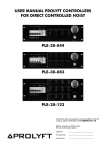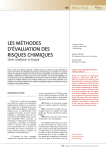Download Power Transmission Installation and Operating Instructions for Brake
Transcript
® Power Transmission Installation and Operating Instructions for Brake EV/EH 018 FEM EV/EH 024 FEM EV/EH 028 FEM EV/EH 038 FEM E 09.754e Schaberweg 30-34 61348 Bad Homburg Germany Telephone +49 6172 275-0 Telefax +49 6172 275-275 www.ringspann.com [email protected] Installation and Operating Instructions for Brake EV FEM and EH FEM Spring activated – electromagnetically released Size 018, 024, 028, 038 Issue: 13.07.15 Version : 1 drawn: MAYA checked: EISF E 09.754e pages: 25 page: 2 IMPORTANT Please read these instructions carefully before installing and operating the product. Your particular attention is drawn to the notes on safety. These installation and operating instructions are valid on condition that the product meets the selection criteria for its proper use. Selection and design of the product is not the subject of these installation and operating instructions. Disregarding or misinterpreting these installation and operating instructions invalidates any product liability or guarantee by RINGSPANN; the same applies if the product is taken apart or changed. These installation and operating instructions should be kept in a safe place and should accompany the product if it is passed on to others -either on its own or as part of a machine- to make it accessible to the user. SAFETY NOTICE Installation and operation of this product should only be carried out by skilled personnel. Repairs may only be carried out by the manufacturer or accredited RINGSPANN agents. If a malfunction is indicated, the product or the machine into which it is installed, should be stopped immediately and either RINGSPANN or an accredited RINGSPANN agent should be informed. Switch off the power supply before commencing work on electrical components. Rotating machine elements must be protected by the purchaser to prevent accidental contact. Supplies abroad are subject to the safety laws prevailing in those countries. Installation and Operating Instructions for Brake EV FEM and EH FEM Spring activated – electromagnetically released Size 018, 024, 028, 038 Issue: 13.07.15 Version : 1 drawn: MAYA checked: EISF E 09.754e pages: 25 page: 3 Contents 1. General remarks 1.1 General safety instructions 1.2 Special safety instructions 2. Function, Markings, Technical Details, Parts list 2.1 2.2 2.3 2.4 Function Markings Technical details Drawing and parts list 3. Proper use / specified purpose 4. Improper use 5. Condition upon delivery 6. Handling and storage 7. Technical requirements for safe and reliable operation 8. Installation of the RINGSPANN brake 8.1 8.2 8.3 8.4 8.5 8.6 General instruction for assembly and installation Prior assembly and installation Adjust to the brake disc thickness and mounting the brake Electrical connection Brake force adjustment Manual brake release 9. Commissioning 10. Disassembling the brake 11. Maintenance 11.1 General maintenance 11.2 Brake pad adjustment, permissible brake pad wear and brake pad replacement 12. Accessories: switches 12.1 Installing and connecting the inductive proximity switches for brake closed, brake open and brake pad wear adjustment necessary Installation and Operating Instructions for Brake EV FEM and EH FEM Spring activated – electromagnetically released Size 018, 024, 028, 038 Issue: 13.07.15 1. Version : 1 drawn: MAYA checked: EISF E 09.754e pages: 25 page: 4 General remarks 1.1 General safety instructions Please read these installation and operating instructions carefully before installing and operating the brake. Please refer also to the drawings in the various sections. Safety must be given the highest priority during all work performed on the brake. Switch off the drive unit before performing work on the brake. Rotating components (e.g. brake disc) must be secured by the operator to prevent accidental contact. 1.2 Special safety instructions Danger to life and limb! It is essential to secure the entire drive train against inadvertent starts during brake installation and maintenance. Rotating components can cause severe injuries. Therefore, rotating components (e.g. brake disc) must be secured by the operator to prevent accidental contact. 2. Function, Markings, Technical Details, Parts list 2.1 Function The brakes of type EV an EH are machine components, used for the purpose of braking accelerated masses safely and reliably. The combination of brake and brake disc provides a complete brake unit capable of securing machines and equipment system effectively. Thanks to its universal design, it can perform the following functions: As a holding or parking brake, it prevents the unintended start of a stationary shaft. As a stopping brake, it brings a rotating shaft to a complete standstill. Braking force is generated by spring force. The brake is released electromagnetically. 2.2 Markings These installation and operating instructions apply to: the types EV018FEM, EV024FEM, EV028FEM, EV038FEM, EH018FEM, EH024FEM, EH028FEM und EH038FEM. installation on horizontal brake discs and vertical brake discs in combination with horizontal shafts for models with and without switches for different brake pad material and for brake pads with signal cables. Installation and Operating Instructions for Brake EV FEM and EH FEM Spring activated – electromagnetically released Size 018, 024, 028, 038 Issue: 13.07.15 Version : 1 drawn: MAYA checked: EISF E 09.754e pages: 25 page: 5 On the brake you can find a name plate with a 16 digit material number. Only with that type number you can specify the brake. Please consult the drawings in each section when using this instructions. 2.3 Technical details EV / EH 018FEM EV / EH 024FEM EV / EH 028FEM EV / EH 038FEM 3000 N 5000 N 10000 N 20000 N 0,3 mm 0,3 mm 0,3 mm 0,3 mm 5 mm 5 mm 7 mm 7 mm 0,5 mm 0,5 mm 0,5 mm 0,5 mm 50 – 100% 50 – 100% 60 – 100% 60 – 100% 6,5 kg 13 kg 24 kg 50 kg 125 mm 250 mm 300 mm 430 mm type 12,5 8 bis 15mm 10 bis 16 mm 10 bis 16 mm 12,5 bis 20 mm type 25 16 bis 20 mm 18 bis 26 mm 18 bis 26 mm 22 bis 30 mm 230/240VAC 380VAC 400/415VAC 230/240VAC 380VAC 400/415VAC 230/240VAC 380VAC 400/415VAC 380VAC 400/415VAC 50 or 60 Hz 50 or 60 Hz 50 or 60 Hz 50 or 60 Hz 16 A, time-lag 16 A, time-lag 16 A, time-lag 16 A, time-lag Power consumption „brake open“ 10 W 10 W 20 W 30 W Electrical degree of protection IP 65 IP 65 IP 65 IP 65 PE conductor PE conductor PE conductor PE conductor Duty cycle 100 % 100 % 100 % 100 % Max. switching frequency at 20°C 3) ambient temperature 240 / h 240 / h 240 / h 240 / h -30°C .. +65°C -30°C .. +65°C -30°C .. +65°C -30°C .. +65°C Clamping force (at 380/400/415VAC) 1) Nominal air gap each side Max. friction pad wear 2) Friction pad wear without adjustment Clamping force / braking torque 1) adjustable Weight [kg] Smallest brake disc diameter Brake disc thickness Supply voltage 1) Supply voltage frequency Electric fuse Insulation class Ambient temperature 3) 1) The nominal clamping force and the adjustment range reduces with the use of 230/240 supply voltage. See also chapter 8.4. 2) The max. allowable friction pad wear depends on the brake disc thickness. See also chapter 11.2. 3) Higher ambient temperature as 20°C reduces the max. switching frequency per hour. Installation and Operating Instructions for Brake EV FEM and EH FEM Spring activated – electromagnetically released Size 018, 024, 028, 038 Issue: 13.07.15 Version : 1 2.4 Drawing and Parts list drawn: MAYA checked: EISF E 09.754e pages: 25 page: 6 Installation and Operating Instructions for Brake EV FEM and EH FEM Spring activated – electromagnetically released Size 018, 024, 028, 038 Issue: 13.07.15 Version : 1 drawn: MAYA checked: EISF E 09.754e pages: 25 Information! For a clear assignment the 16 digit material number of the brake is necessary. Quantity Part 1 2 3 4 5 6 7 8 9 10 11 12 13 14 15 16 17 18 19 Nomenclature Set brake pad Solenoid housing with coil Solenoid lid Slide bushing Tension spring Retaining plate Washer DIN125 Hexagon head screw ISO4017 Coiled spring pin Bearing pin Slide bushing Slide bushing Calotte Cylindrical roller DIN5402 Cylindrical roller DIN5402 Hexagon nut Threaded pin with hexagon head Threaded pin Slide bushing 018 024 028 038 1 1 1 1 4 4 8 8 1 1 2 1 1 1 1 1 1 1 1 1 1 1 2 4 4 8 8 1 1 2 1 1 1 1 1 1 1 1 1 1 1 2 4 4 8 8 1 1 2 1 1 1 1 1 1 1 1 1 1 1 1 4 4 8 8 1 1 2 1 1 1 1 1 1 1 1 page: 7 Installation and Operating Instructions for Brake EV FEM and EH FEM Spring activated – electromagnetically released Size 018, 024, 028, 038 Issue: 13.07.15 20 21 22 23 24 25 26 27 28 29 30 31 32 33 34 35 36 37 38 39 40 41 42 43 44 45 46 47 48 49 50 51 52 53 54 55 56 57 58 59 60 61 62 Version : 1 Wiper Washer DIN125 Hexagon nut DIN985 Hexagon socket head cap screw DIN912 Washer DIN125 Hexagon nut DIN934 Washer DIN125 Spring compressor Dowel pin Lever Washer Lever pressure piece Slide bushing Electronic housing Electronic Plug GSA3000 Gasket, flat GSA Gasket, flat GDM Plug GDME Base plate Hexagon nut Threaded pin with hexagon head Hexagon socket head cap screw DIN912 Spring compression nut Threaded pin Washer Compression spring Guide rod Circlip AV Guide rod Slide bushing Compression spring Screw Attachment plate V Adapter plate H Attachment plate H Hexagon socket head cap screw DIN6912 Attachment plate H Electronic housing 018 Socket CA3-GD Plug CA3-LD Plug CA3-LS Socket CA3-GS drawn: MAYA 1 1 1 1 1 1 1 1 1 1 1 1 1 1 1 1 1 1 1 4 1 1 4 1 1 2 2 2 2 2 1 1 1 3 1 1 1 1 1 checked: EISF 1 1 1 1 1 1 1 1 1 1 1 1 1 1 1 1 1 1 1 1 1 1 4 1 1 4 1 1 2 2 2 2 2 1 1 1 4 - 1 1 1 1 1 1 1 1 1 1 1 1 1 1 1 1 1 1 1 1 1 4 1 1 4 1 1 2 2 2 2 2 1 1 - E 09.754e pages: 25 1 1 1 1 1 1 1 1 1 1 1 2 1 1 1 1 1 1 1 1 1 4 1 1 1 1 1 2 2 2 2 2 1 1 - page: 8 Installation and Operating Instructions for Brake EV FEM and EH FEM Spring activated – electromagnetically released Size 018, 024, 028, 038 Issue: 13.07.15 3. Version : 1 drawn: MAYA checked: EISF E 09.754e pages: 25 page: 9 Proper use / specified purpose The brake may only be connected with 230VAC, 240VAC, 380VAC; 400VAC or 415VAC, with 50Hz or 60Hz and corresponding to the technical details. The electrical connection and the adjustment of the frequency see chapter 8.4. The brake is designed for use as a holding/parking brake and/or stopping brake. Other uses are improper and incompatible with the specified purpose. RINGSPANN assumes no liability for damages resulting from improper use. The risk is assumed by the user alone. 4. Improper use Operating the brake with other supply voltage as specified in the technical details is prohibited. To switch the brake without brake disc is only allowed if the assembly locking nut Pos. 25 in Fig. 5.1 remains on the brake and is loosened not more than 4 mm. Repeated switching without brake disc and without assembly locking nut can damage the brake. Unauthorized constructive modifications of the brake are similarly prohibited. For damages caused by switching the brake without brake disc or unauthorized constructive modifications RINGSPANN assumes no liability for damages resulting from improper use. The risk is assumed by the user alone. Attention! To switch the brake without brake disc is only allowed if the assembly locking nut Pos. 25 and washer Pos. 26 in Fig. 5.1 remains on the brake and the nut is loosened not more than 4 mm. 5. Condition upon delivery The brake is tested prior to delivery. The brake is delivered ready to install. The compression spring for the clamping force is fixed in the open position by the assembly locking nut Pos. 25 in Fig. 5.1. Size 018 024 028 038 Assembly locking nut M12 M12 M12 M20 Installation and Operating Instructions for Brake EV FEM and EH FEM Spring activated – electromagnetically released Size 018, 024, 028, 038 Issue: 13.07.15 Version : 1 drawn: MAYA checked: EISF E 09.754e pages: 25 page: 10 Fig. 5.1 6. Handling and storage The weight of the brake depends on the size, between 6,5kg and 50kg, see also chapter 2.3. The brake is delivered with anti-corrosion protection and can be stored in an enclosed, dry space for up to 12 months. It is important to prevent condensation from forming. Moist storage areas are unsuitable. 7. Technical requirements for safe and reliable operation Mounting the brake to stable, low-vibration machine components ensures low-screech, low-noise braking. 8. Installation of the RINGSPANN brake 8.1 General instructions for assembly and installation Before installing the brake, the brake disc must be cleaned with alcohol, e.g. ethyl or isopropyl alcohol or a water-based surfactant solution (soapy water, etc.) and then rubbed dry with a clean cloth. When cleaning the brake disc with a thinner, acetone or a brake cleaning agent, it is important to ensure that neither these cleaners nor any cleaner residues come in contact with the brake pads. This is especially important in the case of brakes used only as parking brakes, as no dynamic braking operations take place during which thinner residues would be rubbed off the brake disc. Please note! Oil and rust-proofing-agent residues reduced friction coefficient and thus diminish transmissible braking torque substantially! Installation and Operating Instructions for Brake EV FEM and EH FEM Spring activated – electromagnetically released Size 018, 024, 028, 038 Issue: 13.07.15 Version : 1 drawn: MAYA checked: EISF E 09.754e pages: 25 page: 11 8.2 Prior assembly and installation Prior to installation, check to ensure that the mounting surface is even and concentric run between the brake disc and the mounting surface is within the tolerance range of 0.2 mm. Ensure that the parallel gap of 0.2 mm between the brake disc and the mounting surface is not exceeded. Check the axial movement of the brake disc. Axial movement must not exceed ± 0.2 mm. Maximum permissible lateral brake disc wobble is 0.1 mm. Greater wobble may cause rattling and shaking of the brake unit. Attention! Check to ensure that the brake disc rotates freely. 8.3 Adjust the brake to the brake disc thickness and mount the brake The brake is delivered with a distance between the friction pads of 13,1 mm, 20,6 mm or 25,6 mm. You can adjust the distance between the friction pads with the setting screw Pos. 17 and Pos. 41 (see Fig. 8.1 or Fig. 8.2). The adjustment of the air gap between the friction pads and the brake disc is the same as the adjustment of the brake disc thickness. You can adjust the air gap with the setting screw Pos. 17 and Pos. 41 (see Fig. 8.1 or Fig. 8.2). The air gap between the friction pad and the brake disc for the size 018 must not exceed 0,2 mm. For the sizes 024, 028 and 038 the air gap should be 0,3 mm. A bigger air gap reduces the braking force! During installation, ensure that the brake pads are centred and in full contact with the surface of the brake disc. For the distance X and Z see table 8.2 or 8.3. See also Fig. 8.1 or 8.2. Type EV018.. EV024.. EV028.. EV038.. Distance X 48 mm 64,5mm 79 mm 103 mm Distance Z 24,5 mm 19 mm 20 mm 27 mm Rubbing surface Y 42 mm 47 mm 62 mm 72 mm Tab. 8.2 Installation and Operating Instructions for Brake EV FEM and EH FEM Spring activated – electromagnetically released Size 018, 024, 028, 038 Issue: 13.07.15 Version : 1 drawn: MAYA checked: EISF E 09.754e pages: 25 Fig. 8.1 Type EH018.. EH024.. EH028.. EH038.. Distance X 60,5 mm 84,5 mm 99 mm 126 mm Distance Z 24,5 mm 19 mm 22 mm 29,5 mm Rubbing surface Y 42 mm 47 mm 62 mm 72 mm Tab. 8.3 Fig. 8.2 page: 12 Installation and Operating Instructions for Brake EV FEM and EH FEM Spring activated – electromagnetically released Size 018, 024, 028, 038 Issue: 13.07.15 Version : 1 drawn: MAYA checked: EISF E 09.754e pages: 25 page: 13 The brake is attached with 4 screws. The tightening torques refers to screws lubricated with Molycote MoS2. So the screws must be lubricated with Molycote MoS2. Size 018 024 028 038 Screw size M10-10.9 M12-10.9 M16-10.9 M20-10.9 63 Nm 108 Nm 264 Nm 517 Nm Tightening torque (lubricated with MoS2) Tab. 8.1 Information! To facilitate installation, you may fix the brake in position initially with a single screw before swinging it to the point at which the other screws can be inserted as well. aufs führen! Attention! The air gap between brake pad and brake disc is to be adjusted after the first installation and after replacement of brake pads. After the Adjustment of the air gap the setting screw Pos. 17 and Pos. 41 must be fixed with the nut Pos. 16 and Pos. 40, see Fig. 8.1 or Fig. 8.2. 8.4 Electrical Connection Attention, Danger of crushing! To protect the electronic against too fast switching, a security feature is integrated in the electronic. The security feature locks the supply voltage and the brake cannot be opened. After 20 s the electronic will pass the supply voltage and the brake will open automatically. If this happen, do not touch the brake until the brake is open again. Installation and Operating Instructions for Brake EV FEM and EH FEM Spring activated – electromagnetically released Size 018, 024, 028, 038 Issue: 13.07.15 Version : 1 drawn: MAYA checked: EISF E 09.754e pages: 25 page: 14 Attention! Only trained electrician are allowed to connect the brake with the supply voltage. The trained electrician must be familiar with the relevant standards (e.g. in Germany DIN VDE 0113). Attention! To use the brake the electronic Pos. 34 (included in the scope of delivery) is mandatory. Do not connect the brake directly to the supply voltage. Attention! A motor protection switch is not allowed. A motor protection switch destroys the electronic. Attention! To switch the brake without brake disc is only allowed if the assembly locking nut Pos. 25 in Fig. 5.1 remains on the brake and is loosened not more than 4 mm. The following rules must be observed: a) It is not allowed to use coiled cables in the supply line. (e.g. cable drum, reserve cable loops or the like) b) For safe operation of the brake a sufficient grid quality is necessary. See also the standards of grid quality. c) If electrical motors are connected in parallel to the brake, overvoltage protection switches must be used (recommended products are „Bourns“ type 1250, serial code 1250-1S-400 or 1250-2S-400) – do not use inductive line filters or inductive overvoltage filters! d) Before replacing the electronic, check the coil of the solenoid to be shure that the coil is not damaged. Please consult RINGSPANN. Installation and Operating Instructions for Brake EV FEM and EH FEM Spring activated – electromagnetically released Size 018, 024, 028, 038 Issue: 13.07.15 Version : 1 drawn: MAYA checked: EISF E 09.754e pages: 25 page: 15 For the electrical connection oft he brakes size 024, 028 and 038 a plug GDME-2011 (Hirschman) is in the scope of delivery. GDME-2011 GDME-2011 Electronic ON Electronic Fig. 8.3 1 Contact assignment plug GDME-2011 : 1 2 3 PE L1 L2 or N not connected ground Adjust grid frequency : frequency toggle switch ON = 60 Hz frequency toggle switch 1 = 50 Hz (see Fig. 8.3) Degree of protection : IP 65, gasket necessary (in the scope of delivery). Electrical fuse : 16 A, time-lag Supply cable : 1,5-2,5 mm² flexible, do not lay the supply cable together with other electrical motors in one cable duct. Switching function Switching device : : !! No motor protection switch !! directly on the operating voltage – double pole switching! Inrush current 20 A (eff) for 0,3s, than smaller 1 A (eff) After the electrical connection you have to check the protective earth conductor function (according DIN VDE 0113 or EN 60204). Installation and Operating Instructions for Brake EV FEM and EH FEM Spring activated – electromagnetically released Size 018, 024, 028, 038 Issue: 13.07.15 Version : 1 drawn: MAYA checked: EISF E 09.754e pages: 25 page: 16 For the size 018 a seperate electronic module is to be used. The electrical connection at the brake is done via a plug GDME-2011. Attention - SIZE 018 !! Do not disconnect the plug GDME-2011or CA3-LS at size 018 while the brake is under voltage, this will destroy the solenoid! If you have no switch installed, you can disconnect the plug CA3-LD (incoming supply voltage) for testing the function of the brake (see Fog. 8.4). Attention, Danger of crushing! To protect the electronic against too fast switching, a security feature is integrated in the electronic. The security feature locks the supply voltage and the brake cannot be opened. After 20 s the electronic will pass the supply voltage and the brake will open automatically. If this happen, do not touch the brake until the brake is open again. For the connection between the brake and the electronic module the plug GDME-2011 and CA3LS is used. To connect the supply voltage to the electronic module a plug CA3-LD is to be used. All the plugs are in the scope of delivery and from the company Hirschmann. Electronic module ON 1 Fig. 8.4 Contact assignment CA3-LD: cable contact assignment: 1 2 3 PE L1 L2 or N not connected ground CA3-LS ============ GDME-2011: 1 ---------------------- 1 2 ---------------------- 2 3 not connected 3 PE ------------------- PE Installation and Operating Instructions for Brake EV FEM and EH FEM Spring activated – electromagnetically released Size 018, 024, 028, 038 Issue: 13.07.15 Version : 1 drawn: MAYA checked: EISF E 09.754e pages: 25 Adjust grid frequency : frequency toggle switch ON = 60 Hz frequency toggle switch 1 = 50 Hz (see Fig. 8.4) Degree of protection : IP 65, gasket necessary (in the scope of delivery). Electrical fuse : 16 A, time-lag supply cable : 1,5-2,5 mm², not longer than 50m; do not lay the supply cable together with other electrical motors in one cable duct. page: 17 !! No motor protection switch !! cable between CA3-LS : 1,5-2,5 mm2 flexibel, not longer than 3m. and GDME-2011 Switching function : directly on the operating voltage – double pole switching! Switching device : Inrush current 15 A (eff) for 0,3ms, than smaller 1 A (eff) After the electrical connection you have to check the protective earth conductor function (according DIN VDE 0113 or EN 60204). 8.5 Braking force adjustment The entire surface of both brake pads must be in contact with the brake disc in order to achieve the optimum braking effect. The brake pads must also be heated briefly to approx. 200°C. Therefore, multiple brief braking operations under low spring force and rotating brake disc are required to heat the brake pads. Attention! If the brake is used as parking brake, the brake torques specified are not met. Reductions of up to 50% of the braking torques are possible. Attention! If the brake cannot be run in, the braking torques listed in our publication no. 46 cannot be achieved. Reductions of up to 50% are possible. The brakes are preset and delivered with a nominal clamping force at a supply voltage of 380/400/415VAC. If the brakes are used with a supply voltage of 230/240VAC you have to reduce the spring force. Therefore you have to loosen the threaded pin Pos. 44 of the spring compression nut Pos. 43. With the spring compression nut you can adjust the distance S (see Fig. 8.5) according to the values in table 8.3. After the adjustment, lock the spring compression nut with the threaded pin. Installation and Operating Instructions for Brake EV FEM and EH FEM Spring activated – electromagnetically released Size 018, 024, 028, 038 Issue: 13.07.15 Version : 1 drawn: MAYA checked: EISF E 09.754e pages: 25 page: 18 Fig. 8.5 EV / EH 018 EV / EH 024 EV / EH 028 EV / EH 038 Supply voltage [VAC] 230 240 380 400 415 230 240 380 400 415 230 240 380 400 415 380 400 415 Nominal clamping force (100%) [N] 3000 3000 4000 5000 7500 10000 20000 2400 2400 3600 4000 6400 8000 16000 DA - 46 DA - 46 DA - 51 DA - 51 DA - 66 DA - 66 DA - 76 Braking torque [Nm] at DA= 200 185 185 - - - - - DA= 250 245 245 320 400 - - - DA= 300 305 305 400 500 700 940 - DA= 355 370 370 490 610 870 1160 - DA= 430 460 460 610 760 1090 1460 2830 DA= 520 570 570 750 940 1360 1820 3550 DA= 630 700 700 930 1160 1690 2260 4430 DA= 710 800 800 1050 1320 1930 2580 5070 60-100 50-100 60-100 50-100 80-100 60-100 60-100 15,5 22,5 14 19 4,5 13,5 1) Braking force [N] Friction diameter [mm] DR = 1)2) Clamping force, adjustable [%] 3) Distance S [mm] 1) Braking force and braking torque is calculated with a theoretical friction coefficient of 0,4 and 100% clamping force. 2) DA = Outer diameter of the brake disc in mm. 3) With the distance S, 100% clamping force is achieved. With S = 0 mm the smallest adjustable clamping force is achieved. Tab. 8.4 8.6 Manual brake release For manual brake release you can use the assembly locking nut Pos. 25 and washer Pos. 26 see Fig. 5.1. To open the brake screw on the nut. Installation and Operating Instructions for Brake EV FEM and EH FEM Spring activated – electromagnetically released Size 018, 024, 028, 038 Issue: 13.07.15 Version : 1 drawn: MAYA checked: EISF E 09.754e pages: 25 page: 19 9. Commissioning Attention! To switch the brake without brake disc is only allowed, if the assembly locking nut Pos. 25 in Fig. 5.1 remains on the brake and is loosened not more than 4 mm. Before commissioning you have to switch on the electric current (the solenoid holds the brake open) and the assembly locking nut Pos. 25, Fig. 5.1 is to be removed. The brake is now ready for operation. 10. Disassembling the brake Danger to life and limb! When disassembling the brake it is essential to ensure that the entire drive train is secured against inadvertent activation. Rotating components can cause severe injuries. Therefore, rotating components (e.g. brake discs) must be secured against accidental contact. To prevent injuries to personnel, secure the brake with the aid of an assembly locking device. Attention - SIZE 018 !! Do not disconnect the plug GDME-2011or CA3-LS at size 018 while the brake is under voltage, this will destroy the solenoid! If you have no switch installed, you can disconnect the plug CA3-LD (incoming supply voltage) for testing the function of the brake (see Fig. 8.4). Secure the open position with the assembly locking nut Pos. 25 and washer Pos. 26 in Fig. 5.1. Therefore you have to switch on the electric current. After the brake is secured with the assembly locking nut in open position switch off the electric current. Attention! Take care, that the electric supply cable is currentless. Installation and Operating Instructions for Brake EV FEM and EH FEM Spring activated – electromagnetically released Size 018, 024, 028, 038 Issue: 13.07.15 Version : 1 drawn: MAYA checked: EISF E 09.754e pages: 25 page: 20 Remove the plug Pos. 38 from the brake. Attention! Secure the brake for disassembly Remove the screws used to hold the brake in place. The brake can now removed from the mounting surface. 11. Maintenance 11.1 General maintenance Maintenance must be performed on the brake at intervals of 4 weeks up to once a year, depending upon the operating load. Perform the following checks during every maintenance operation: Check brake pads for wear. Check the bolt connection between the brake pad and the machine component as well as the bolt connections for the retaining plates for tightness. Check the electric supply cables (sight check) 11.2 Brake pad adjustment, permissable brake pad wear and brake pad replacement Danger to life and limb! Brake pads may be replaced only when the equipment system and/or the working machine is at a complete standstill! Attention! Brake pads must not be worn to a residual thickness (mounting plate thickness plus remaining pad material). Brake pads must always be replaced in pairs. To counter brake pad wear you can adjust the distance between brake pad and brake disc with set screws Pos. 41 and Pos. 17 (see Fig. 8.1 or 8.2). Therefore you have to switch on the electric current and screw on the assembly locking nut Pos. 25 in Fig. 5.1. The gap between brake disc and brake pad on each side should be 0,3 mm. A greater gap will reduce braking force. Consider the maximum permissible wear of the brake pads (see table 11.1). Installation and Operating Instructions for Brake EV FEM and EH FEM Spring activated – electromagnetically released Size 018, 024, 028, 038 Issue: 13.07.15 Version : 1 drawn: MAYA E 09.754e checked: EISF pages: 25 page: 21 After the adjustment of the gap between brake disc and brake pad, lock the set screw Pos. 41 and Pos. 17 with the locking nut Pos. 16 and Pos. 40. ) Remove the assembly locking nut Pos. 25, Fig. 5.1 The brake is now ready for operation again. Attention! The gap between brake disc and brake pad on each side should be 0,3 mm (for size 018 = 0,2 mm). A greater gap will reduce braking force. Consider the maximum permissible wear of the brake pads (see table 11.1). Size 018 Brake disc thickness from 8 …11mm and 16 … 17 mm 9 mm Brake disc thickness from >11 … 15 mm and >17 … 20 mm 7 mm Size 024 1) Residual thickness Residual thickness 1) 1) Brake disc thickness 10mm and 18 … 19 mm 13 mm Brake disc thickness from >10 … 16 mm and >19 … 26 mm 11 mm Size 028 Residual thickness 1) Brake disc thickness 10mm and 18 …19 mm 17 mm Brake disc thickness from >10 … 16 mm and >19 … 26 mm 13 mm Size 038 Residual thickness 1) Brake disc thickness from 22 … 23 mm 17 mm Brake disc thickness from 12,5 … 20 mm and >23 … 30 mm 15 mm Residual thickness = backplate of the brake pad + residual brake pad Tab. 11.1 Brake pad replacement: Before replacing the brake pads Pos. 1, ensure that the mass held by the brake is secured to prevent movement, as parts of the brake must be loosened/removed for replacement. Before replacing the brake pads switch on the electric current (the solenoid opens the brake) and secure the the brake with the assembly locking nut Pos. 25 and washer Pos.26 (see Fig. 5.1). Switch off the electric current. Remove all tension springs Pos.5 and one of two retainig plates Pos. 6 each side, see Fig. 11.1 Pull out the old brake pads and screw out the set screws Pos. 17 and Pos. 41, Fig. 8.1, so that the new brake pads can easily inserted. Take care, that the chamfer on the brake pad is on the Installation and Operating Instructions for Brake EV FEM and EH FEM Spring activated – electromagnetically released Size 018, 024, 028, 038 Issue: 13.07.15 Version : 1 drawn: MAYA checked: EISF E 09.754e pages: 25 page: 22 outer diameter of the brake disc and the friction material of the brake pad is on the brake disc side. Fasten the retaining plates again (tightening torque, see table 11.1). Fig. 11.1 Screw 1) Tightening torques 1) Size 018 M6-8.8 11 Nm Size 024 M8-8.8 27 Nm Size 028 M10-8.8 54 Nm Size 038 M12-8.8 93 Nm Screw secured with Loctite 243. Tab. 11.1 After replacing the brake pads, you have to adjust the air gap between the brake disc and the brake pad. See the first steps in this chapter. 12. Accessories: switches for brake closed, brake open and brake pad wear adjustment Necessary (Option) 12.1 Installing and connecting the inductive proximity switches for brake closed, brake open and brake pad wear adjustment necessary Danger to life and limb! The inductive proximity switch may be installed and/or replaced only when the equipment system and/or working machine is at a complete standstill! Installation and Operating Instructions for Brake EV FEM and EH FEM Spring activated – electromagnetically released Size 018, 024, 028, 038 Issue: 13.07.15 Version : 1 drawn: MAYA E 09.754e checked: EISF pages: 25 page: 23 Danger! When switching the brake, the lever Pos. 29 and the spring compressor Pos. 27 will move very fast. You have to go through chapter 8 first, before you can assemble the inductive proximity switch. The assembly of the inductive proximity switch is only possible after the brake is assembled and the air gap between brake pad and brake disc is set correctly (see chapter 8 and 9). To indicate „Brake open“, „Brake closed“ or “Brake pad adjustment necessary” a inductive proximity switch for each request is to assemble. The inductive proximity switch is part of the sensor kit and supplied loose as accessory. The sensor kit consists of an inductive proximity switch with two fastening nuts, a fastening sheet metal and fastening screws and washers. On the brake housing you can find threads to fasten the fastening sheet metal (see Fig. 12.1). On the metal sheet you have different assembling possibilities for “Brake open”, “Brake closed” and “Brake pad wear adjustment necessary” (see Fig. 12.2). You always get a “high-signal” for each brake status. With one sensor kit you can detect only one brake status, for further signals you have to order another proximity switch in NC or NO version (see Tab. 12.1). Sensor kit: size 018 size 024 size 028 size 038 Brake open (NC) 3500-112005-000000 Brake open (NC) 3500-112005-000000 Brake open (NO) 3500-112002-000000 Brake open (NO) 3500-112003-000000 Brake closed (NO) 3500-112004-000000 Brake closed (NO) 3500-112004-000000 Brake closed (NO) 3500-112002-000000 Brake closed (NO) 3500-112003-000000 Adjust brake pad wear (NO) 3500-112004-000000 Adjust brake pad wear (NO) 3500-112004-000000 Adjust brake pad wear (NO) 3500-112002-000000 Adjust brake pad wear (NO) 3500-112003-000000 Tab.12.1 To adjust the inductive proximity switch for brake pad wear, you can increase the airgap between brake disc and brake pad on each side to a value of 0,6mm. Then switch off the brake (brake is closed). Then fasten the inductive proximity switch in a way that the LED is almost glowing. Then reduce the airgap to 0,3mm again. Switch on the brake, the LED must not glow after the brake is in open position. Test the proper function by switching the brake. The LED of the proximity switch must glow, if the brake status you want to detect is reached. Fig. 12.1 Installation and Operating Instructions for Brake EV FEM and EH FEM Spring activated – electromagnetically released Size 018, 024, 028, 038 Issue: 13.07.15 Version : 1 drawn: MAYA checked: EISF E 09.754e pages: 25 Brake status indication size 018 and 024: Brake open Brake pad wear adjustment necessary Brake closed Brake status indication size 028: Brake closed Brake pad wear adjustment necessary Brake open Brake status indication size 038: Brake closed Brake pad wear adjustment necessary Brake open Bild 12.2 page: 24 Installation and Operating Instructions for Brake EV FEM and EH FEM Spring activated – electromagnetically released Size 018, 024, 028, 038 Issue: 13.07.15 Version : 1 drawn: MAYA checked: EISF E 09.754e pages: 25 page: 25 Technical details of the inductive proximity switch: For inductive proximity switch 3504-000070-000000, contained in switch kit 3500-112003-000000, 3500-112002-000000 und 3500-112004-000000: Switching function Operating voltage Current consumption Polarity protect Housing Connection Short-curcuit protection : PNP (Closer, NO) : 10....36 V DC : < or = 15 mA : yes : brass, coated : M12 connector : yes Sensing range : 4 mm, non-flush Current rating : 150 mA Voltage drop : < 2,5 V Status indication LED : yellow Protection : IP 67 Ambient temperature : -25 bis +80°C Wiring For inductive proximity switch 3504-000071-000000, contained in switch kit 3500-112004-000000: Switching function Operating voltage Current consumption Polarity protect Housing Connection Short-curcuit protection Wiring : PNP (Opener, NC) : 10....36 V DC : < or = 15 mA : yes : brass, coated : M12 connector : yes Sensing range : 4 mm, non-flush Current rating : 150 mA Voltage drop : < 2,5 V Status indication LED : yellow Protection : IP 67 Ambient temperature : -25 bis +80°C






























